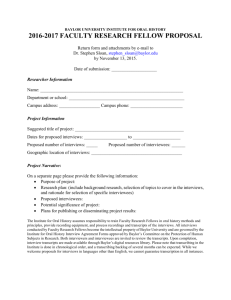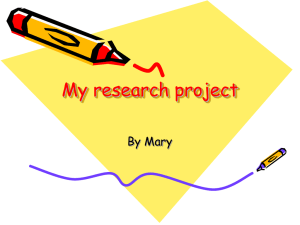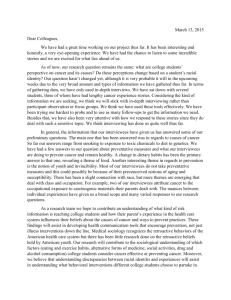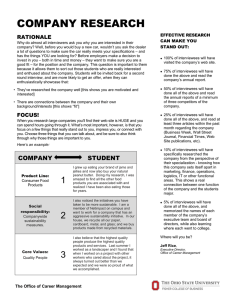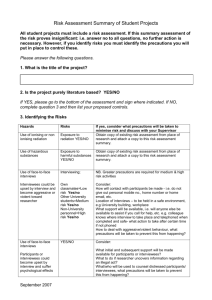October 1987 UNDERSTANDING THE
advertisement
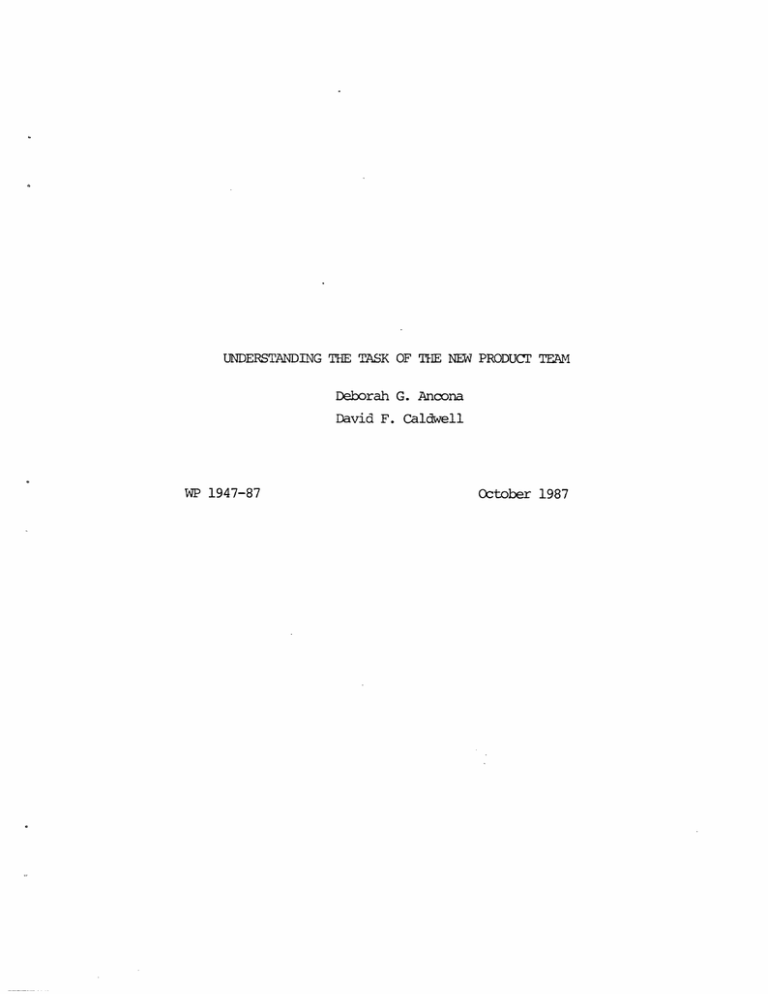
UNDERSTANDING THE TASK OF TIE NEW PRODUCT TEAM Deborah G. Ancona David F. WP 1947-87 Caldwell October 1987 Understanding the Task of the New Product Teaml Deborah G. Ancona Sloan School M.I.T. David F. Caldwell Leavey School of Business Santa Clara University Running Title: New Product Teams Address Correspondence To: 1 David F. Caldwell Department of Management Leavey School of Business Santa Clara University Santa Clara, CA 95053 (408) 554-4114 Support for this research was provided by the Center for Innovation Management Studies, Lehigh University Understanding the Task of the New Product Team DEBORAH G. ANCONA (Ph.D. Columbia University) is an assistant professor in the Sloan School at M.I.T. Her articles on groups have appeared in Administrative Science Quarterly and the Academy of Management Journal. With David Caldwell, she is completing a study large of how the performance of new product teams can be improved. DAVID F. CALDWELL (Ph.D. UCLA) is an associate professor in the Leavey School of Business at Santa Clara University. The results of his research on individual and group performance have recently appeared in the Academy of Management Journal, Journal of Occupational Psychology, and Journal of Applied completing a large study can be improved. Psychology. With Deborah of how the performance of Ancona, he is new product teams Understanding the Task of the New Product Team Interviews with 37 managers of teams developing new products in high technology stages these companies suggest that teams during the product development process. stages has implications go through predictable An understanding of for monitoring the progress of product development and for improving the management of new product teams. New Product Teams Understanding the Task of the New Product Team Pick up any text or article about new product development and you will find a set of sequential stages that organizations should follow in introducing new products. take us through For example, Booz, Allen and Hamilton (3) Idea Generation, Screening and Evaluation, Analysis, Development, Testing and Commercialization. Business Models such as these stages are useful to organizations for monitoring the progress of a new product process (10). describe what over time The value the organization must and can of facilitate the product development such models do is that they, to manage in essence, and improve the product development process. The actual process of developing and coordinating the new product within an organization is often delegated to a new product team (4). This team becomes responsible for not only the technical aspects of the product, but hierarchical also for coordinating levels that have information make the new product a success. product development process the numerous product. The generally lack of resources Descriptions of actions the new product team must take marketable or functional do not the address areas necessary stages of the and to the specific in moving from an idea to a general descriptions of the stages through which the new product team must go to complete its assignment often make it difficult to understand ultimately improve its performance. and monitor the team and 1 New Product Teams Understanding a Team's Task (7) has Recently, Goodman presented a for strong argument the necessity of understanding the task of a group or team as an integral of part any model tasks specific performance. group to complete must a group how understanding of improve has the implications for two including a new group's, any An appreciation of product First, without a clear understanding of a group's team's, performance. task, it is impossible to determine how activities the group undertakes contribute to its success or failure (8). new developing products is unique, we since the task of Second, cannot necessarily barrow conclusions about how to improve a new product team's performance from other types of groups, be they t-groups or sales teams. that indicates Research types in three general engage groups of external. The first represents the actual task designing a may computer those activities needed to have develop and technical, social activities: the group has been assigned must tasks complex completing (8). a to carry out For example a team way of speeding up computation while keeping the new computer compatible with the existing product project Another line. should be activities example divided would be among deciding how team members. The the work second on type a of relate to how members actually become a team and maintain their commitment to the product and the team (12). Examples here might include the development of conflict resolution methods within the group and extent socializing. with other to which group The third refers parts of the loyalty is developed through informal to how the group manages its relations organization (5). Examples of this might 2 New Product Teams include a product team building support with manufacturing to speed up production or negotiating with top management for additional personnel. Most general models social domains, and of groups have focused on the technical and have downplayed the importance of how the group manages relationships with other groups yet the new product development task requires a good deal of external interaction. of studies acquire have investigated information investigated the interacting with how from others broader set other research (e.g. development 1,9,13,14) of activities groups. and Although a number less such groups Understanding groups research has engage in in such activities is particularly important since the failure to do them well may contribute to such common inter-unit problems as marketing-engineering conflict, the "not invented here syndrome," and difficulties with technology transfer. Goals of this Research The purpose of this research is to describe the task of the new product team with particular emphasis on the external activities teams must complete. Our goal is to describe a general model of the stages of the product development process new product team. such from the perspective of the To do so, we examine the activities that new product teams perform as they create a team, gain the support and resources they need, develop a product, and ultimately transfer the ownership of that product to others in the organization. We will focus on the most difficult overcome, stumbling blocks that teams must as well as the changes teams must manage as the demands of product development shift over time. We end by offering some suggestions for managers about how 3 "ll New Product Teams an understanding of the product development process from the team's perspective can improve new product team performance. Methodology As part of a large study on new product team performance, we interviewed 37 new product team managers at seven corporations in the computer, integrated circuit and analytical instrumentation industries. Interviews were semi-structured with an average length of manager to describe, and ranged from one to approximately three hours. in detail, the activities We discuss process shifts and in describe team activities stumbling blocks over that asked each that he and his team members carried out, both within and outside the group; to eight hours, the we asked each product development impeded progress. The interviews were tape recorded and transcribed; the transcriptions were evaluated to identify patterns of activity and transitions in the product development process. This sample is not meant to be representative or large enough to test specific hypotheses. Rather, our goal is to ensure that we adequately describe the task and processes of the new product team and augment the current literature with observations from the field. This research strategy is chosen because we believe that research on complex tasks in organizations is at an early stage of development. Given the lack of formal research on interdependent groups within organizations, we believe phenomena, must all (6). that exploration and description, classification of and attempting to identify observable patterns of activity precede the proposition and testing of specific hypotheses 4 New Product Teams Results Our respondents indicate that the task of product development, at least from the sequential team's phase model pattern did emerge. the new perspective, product suggests. is less straightforward However, for most than the teams a general Two events served to divide the process and direct team's activity. We refer to these events as transition points because they also mark major shifts in the activities of These team members. development process two into development, and diffusion. shift from a transition points three phases which divide the product creation, we label: The first transition point represents "possible product" to "definite product." The involves a transfer of the technology and product ownership new product team to others in the organization. transition points represent crises a second from the For some teams, these in that if the group does not meet certain critical goals its viability is threatened. Our interviews suggest that each phase and transition point require different patterns of team functioning and different patterns of interaction with outsiders on the part of the new product team. will illustrate the nature of the phases and We transition points with excerpts from our interviews and summarize a wider range of activities found across the teams. In addition, we will integrate our data with other relevant research findings. The Creation Phase The first thing I did was to go to talk to lots of people to find out what they thought the product was and how to get there. This was at the technical level, what are the details, not just global I started out with the guy who brought me here, he suggestions. sent me to see someone else, and so it when that I came to talk to a lot of high- and middle-level people. The interviews were open- 5 New Product Teams ended but I pushed and maybe even taught them a few things about their concept; what it meant to produce the product they envisioned. So I gained knowledge about details of what the product ought to be, who the players were, what they did, and what they wanted. It's not exactly clear how the whole thing got started, but then it seldom is. There were these two other projects going on, but they weren't doing too well. So, about a year ago the Product Committee decided to start this new project. We started out by having a meeting with the two old project teams, and members of the top corporate and division management. This was May and we were supposed to have this wonder machine ready to ship by January. After the two former leaders were signed up for the project I pulled in two more key people and had an initial meeting. This was the core of the group. We added a few more people and then spent a couple of weeks frittering about, reading stuff, deciding if the product was feasible. People were saying tno way it can happen' and I was busy setting things up so we'd have a place to live. We moved in and launched into work. Our interviewees typically activity took place across the phase. Most Collecting of these information that a large volume of teams boundary in this early creation activities or reported fell into one of three categories: resources; Modeling the organizational environment; and Building links with other groups. Teams collect large amounts of information: technical information about what is and is not feasible and what the latest innovations have been; market information about what products are selling well and what the competition is doing; and political information about who supports the project and who does not. In addition to collecting information, teams attempt models of how other groups will respond to the product. forecasts of top management's response to the potential "snags" which might occur in the future. to create This includes product concept or 6 New Product Teams Team leaders' developed reports communication suggest links that the new product with other groups who information or resources currently needed by the team. teams also did not have Many of these contacts were undertaken in anticipation of a later phase, when the cooperation and support of the target groups would be needed. cases, communication links were clear influence attempts. In other Here team members would try to shape outside opinion to make it more favorable towards the team. The new product team boundaries at this time. activity as well. the process plan. members of is not solely negotiating its There is a great deal of technical and social Product definition is a clear priority, particularly moving from a very general idea to a specific design One manager described this phase as were occupied with exploring various feasibility. outside "working in the sandbox"; ideas and determining This preceded the difficult job of selecting the best of the alternatives that had been examined. This phase also brought changes as members were added, and people got to know one another. It is a period of exploration and testing of who knows what, and can we rely on this person to get a particular job done. Thus, in terms of their internal interactions, team members define the product, determine feasibility, get to know one another, and begin to develop norms about how to work together. Possible to Definite Project: A Transition Point The design review was set up to make sure we weren't going off in crazy directions. All of R&D was invited, quite a few showed up. We had answers to most of their questions, and we got lots of helpful input. We were official now, they had given us the OK. We went back to work. 7 Ili New Product Teams The first sell was to the R&D staff. We had decided what we wanted to do and we had to get them to agree, the VPs had to sign off. We're spending their money, we have to meet their needs to keep getting resources. We got lots of comments. Then we had to present our responses to their comments at another meeting with a broader audience. We were seeking the blessing of top management. Management just couldn't all get together and decide which chip they were going to use. It was debated and changed and debated and we couldn't really get working. The cost and time to delivery got out of control. We had to scrap the whole thing and most of the team left the company. Our interviews suggest that the first transition point occurs just prior to the shift major portion of the development from recognition of potential new product idea. This minimal organization entails support from top management. In organizationally imposed, our design usually informal brief movement from top management there was review case, to involves a feasibility to commitment sample and defend its time and low-cost design. and that forced their support some formal, new product the Even when this was organizational get usually to one effort with to major capital investment and team to present there was phase not pressure about support. Team the this leaders describe spending a great deal of frenzied time and activity preparing for these reviews, be they formal or informal. Three of transition. support our interviewees Two of the teams difficulties not build both with failed to get agreement with of other groups and could not progress. agree among themselves about could reported and external the The third could not certain technical issues. internal and this These groups consensus on project specifications, hence they could not move from the process of deciding what the product should be to deciding how to actually make the 8 New Product Teams Our interviewees generally reported a shift in activities in product. the teams general that successfully task of the completed team moved this from defining transition point. the new product The idea, determining feasibility, and gaining support for it to actual product development. Development There was a lot of coordinating to do. I wanted to make sure they had ordered the components and the printed circuit boards. George was the liaison to manufacturing, but I needed to check on things once in awhile. As time went on there was so much to watch over that we decided to bring in three people from manufacturing. They helped with the components decisions: which could be obtained, did they have the right performance specs. At this point we also started meeting with people outside the group to provide a status update. We had representatives from purchasing, larger manufacturing areas, production planning, diagnostics and marketing. We informed them of progress and changes and published We the meeting minutes on-line so everyone could access them. also kept the Product Committee informed. By November the top committee was getting panicky: they were nice, but they were nervous. I tried hard to protect the team from the pressure, but the rest of the company was like a pressure cooker. The Some of the team even had to come in during Christmas time. machine just wasn't working and everybody felt as though we'd failed, even though we'd done the impossible. Still we were late to Manufacturing and everyone was scared. Several rules are in place now, such as minimizing new technology so that this thing gets out in time. Now for every piece of the product we have a plan and every Monday morning people have to I'm in the report on where they are with respect to this plan. middle of two ends of a problem. From above I get major direction and goal setting, like we really don't want to deliver in February but in December, and then Monday mornings I get reality. I decided to house us in an isolated building. This was a novel task, there were lots of new people, and we were going to be going hard and fast. That kind of intensity has to be isolated. Besides, if people aren't together the project isn't going to turn People who are working have two out as good as it could have. things to do. One is they have to do the operating system for the project. The other is they have to stay in touch with the rest of the organization, so they are torn. I want people to make project optimizations not local ones. 9 New Product Teams Many of our interviewees described the type of dilemma illustrated in the final quotation. focus much of team leaders The development stage requires that the team its effort internally, on also reported that technical substantial issues. efforts However, were needed to maintain and build relationships with other groups. In this development; phase, the team needs it therefore, can to not be spend its time interrupted on technical constantly. An important dilemma that team leaders talked about is how much separation should be between the there Specifically, even should physically the isolate team and team obtain itself the of separate the from rest rest the organization. facilities of the or perhaps organization? Isolation allows the team to focus on technical innovation and speed team to carry on transactions with but may make it difficult for the other functional groups. Within the group, this stage requires the highest need for close coordination among team members and most teams appear to work out routines and methods for accomplishing this. Isolation allows the group to development phase, the team must shift its activities. move from product definition setting goals and schedules for actual development. to be done, inputs from others During the regarding their to In order for this priorities and suggestions for the product design need to be restricted unless market or competitive information radically changes. difficult product as Isolation to maintain a concept can This restriction may be since other functional that facilitate is open to constant groups may change and information restriction. Groups view the updating. that are unable to restrict this information may lose valuable time and suffer 10 New Product Teams reduced effectiveness. The potential importance of this isolation was illustrated in that two of the three of the team leaders who informed us that their teams failed at this stage, reported continually changing work goals and schedules in response to new information and inputs to be the cause of the failure. Our interviewees characterized failed. by report periods that where group the development members feel as if phase they is have At these times team leaders report that they frequently had to push the group by stressing the importance of the product and continued work on it and maintain the group's spirit by providing a vision of the completed product. During this internal activities, development relations stage, the group's priorities change to managing its stage with however, there others. is our a need Resources interviews to have manage already indicate team been that in activities and obtained and information and mapping of the rest of the organization has been done. Yet behaviors aimed at coordination with other groups tend to increase. The new product team must ensure that other functional groups, those that will provide components and those that will take the product over are working to the schedule agreed upon. During this time, top corporate management needs to be informed of the product's progress as well. Technology Transfer: A Second Transition Point Then we had this big fight. Manufacturing said lets build it and make repairs later. Engineering said let's hold it. I was in the middle. Manufacturing yanked these people out. I was in a tenuous position. I wanted the product to stay with the team to get the bugs out but the product committee and the rest of the organization were going crazy. We had made a deal with some 11 New Product Teams customers. There manufacturing. were huge pressures to get it over to DECLARATION OF IMPATIENCE: A time has come, we believe, to call a halt to product XX engineering and ship the product. We believe it is time to say IT'S DONE!!! Put the unfinished business on the shelf for product 2XX. This product already is the best on the market, by far, and the momentum of things to come will insure that it stays that way. BUT NOT IF IT DOESN'T SHIP! We sell the customer on evolution, not on a solution for all men, for all time, now. Get on with the final game. NO MORE DEVELOPMENT!!! (Memo sent to a new product team by one team leader) A second testing transition point phase. In most normally occurs cases, somewhere technological during problems assessed and a prototype exists and has been tested. the have been The transition consists of moving from team ownership of the product to more general organizational ownership. Our interviewees report a change that is similar to what Quinn and Mueller (11) call a technology transfer point where the emphasis moved from developing the technology to passing information, enthusiasm, and authority to use that technology to other groups in the organization. The transition will not occur if the group is either unwilling to relinquish the product or unwilling to continue to work on the product when it has passed into the hands of others. This was a difficult transition for all the teams we examined. Problems ranged from members who were unwilling to transfer the product to others, projects, to less leaving committed the project manufacturing occurred. decrease in interviewees the For most isolation reported a team members who began and before teams, commitment a smooth this of work on other transition to transition signaled a team shift in team activities members. Many from internal team decisions to "selling" the product idea to other groups. 12 New Product Teams Diffusion and Ending The team now has a whole different form. Those who are helping manufacturing are spending most of their time in New Hampshire at the factory. That is a small subset of the original team. Some of the team members are busy going over documentation and support products. There are still a lot of other groups that have to come through for us to make this product shine. Then there were quite a few people who left when there part of the project was done. They went back to their functional units or joined other teams. Some did this even before I wanted them to, there is so much work still to be done. Then, there are a few who have stayed on along with some new people along with the third generation. This is sort of a transition from one team to another. At this point, the team wasn't meeting much. People didn't seem to know what to do. It was the end of an intense group. People were People weren't ready to start People were zombies. burnt out. over. They hadn't recovered. Maybe I should have been doing some career planning but that's not really what I wanted to do. People I sent all my people on were lost but the product was great. vacation. Our interviewees reported that during the diffusion phase teams' increased activities external transferring technical dramatically as members began data as well as a sense of ownership to other The necessity groups that must manufacture and market the new product. of transferring product ownership causes some obvious difficulties for a team. Some interviewees reported that the nature of the second stage of development the process, particularly if the team has isolated itself, caused teams to develop a very impermeable boundary. the isolation this boundary created may have been Although important in facilitating the internal decision making and group cohesiveness often necessary during the second stage, it occasionally made the product transfer difficult. The team leaders reported that variability of individual involvement in completing the product was high at this stage. The key issue project was keeping those members needed to finish up the 13 III New Product Teams committed to it; while moving those whose efforts were no longer needed on to other activities. A number of team leaders mentioned balancing these responsibilities was difficult. was difficult because the major product that Maintaining motivation development decisions had already been made and what remained was completing product details and transferring the product to other groups. In addition, some individuals resisted career planning or left the group earlier than the leader desired. Implications and Conclusions Our interviews suggest that new product teams follow a pattern as the product development process proceeds. As the product development task change, so do the internal processes of the group and the ways in which it must deal with others in the organization. phases of activity: can be described We found three creation, development, and diffusion. in terms of a dominant task Each phase requirement either exploration, exploitation, or exportation. During the Creation phase, the team must obtain the information and resources it will need initially and in the future. issue for the team at this time is exploration. The dominant Teams must explore what resources are available to them, what the product can and should be, what other areas of the organization want the product to be. addition, teams Exploration must inside explore the team technologies involves and markets getting at to know this other In time. team members, determining who has particular skills, and who can be trusted. Teams exploration then face of numerous a difficult alternatives transition to as commitment they to move a from specific 14 New Product Teams product design. efficient The dominant issue following this transition is the exploitation of the information and resources the team has collected in order to develop the product in the form that was agreed upon. Primary emphasis for the team becomes solving technical problems and efficient team operations. Following a second that of transition, the emphasis for the team becomes exportation of ownership of the its product product to other to others groups. and transferring the During this stage, the emphasis on the team's internal processes declines and the team shifts to working with other functional groups. An understanding of the new product implications product for both development team's task has a number of understanding and process. Among potentially these improving implications are the the following. FIRST An understanding of the product development task allows for the establishment of more meaningful milestones and review cycles. In most transition measured of our from teams, a possible during the formal to a definite development creation or diffusion. reviews were phase associated product. but Milestones often did not exist often frustration during this early phase because were for There was also although groundwork it often did not appear that work was being done. diffusion stage, the The result was often a great deal of time lost during creation, since no one was monitoring progress. was laid, with there is the difficult problem of members In the believing the job is done, when much important detail work remains. Meaningful enthusiasm when milestones the task and review itself does cycles not can create energy and provide tangible feedback. 15 I], New Product Teams For example, in the creation stage important items to monitor might be the extent to manufacturing expertise and outside definition Freedom which the can to group customers the explore and group. be monitored new has In collected identified addition, and creative ideas input key from marketing, areas progress technical may mean broad, of needed toward product ideas rather rewarded. than narrowly defined milestones. During development, PERT charts and coordination mechanisms force more careful monitoring of product progress, but rewards often end when the design is complete. Milestones and rewards also may help in the diffusion stage by encouraging people to complete the details of their work and transfer it to others. SECOND Much of the new product development team's developing and maintaining relationships with other groups. work is Much of the emphasis in group research and "how to" books on team building have stressed internal team functioning. All of our interviews also stressed the importance and relations with other groups. External behaviors ranged from modelling complexities of managing the surrounding environment to negotiating for resources, from opening up communication pressures, and channels to buffering the group from external from translating the meaning of external communications to managing the profile of the group that is shown to outsiders (for a more complete list and explanation of these activities see Ancona and Caldwell (2). The demand for this amount and variety of behavior means that the group must behaviors. have the staff Often, the and skill necessary sole criteria used for to carry on these staffing is technical 16 New Product Teams competence, yet the conceived best product may technical competence must be coupled Hence, help in its development. if it, and work to in the company do not know about it, support others produced be not with skill for internal team management and external boundary-spanning behavior. As the task of the new product team changes over time, THIRD different ways of managing the team are required. The very of the different phases different to actions process require product development During progress. facilitate the sufficient stage, the team manager must ensure that the team receives information and resources to complete its task. work to help the group establish initial The manager must also with relationships others. In addition to these external activities, the manager must allow for the technical and possibilities team members' skills and exploration of abilities. In order to actually create a product concept and begin the development of a team, an atmosphere tolerant of trial and error and a freedom from constraint and procedure should mark this phase. stage, During the second During this time, the manager specifications related to and changes then limit in design. the activities of must act inputs The to and team the team must gain consensus restrict leader shift. on product information flows may devote primary effort to managing the group's internal process and buffering it from the political battles which may be fought at the upper levels hierarchy. of the The potential value of such actions are that they allow the group to work without interruption and to decision making and problem solving. focus directly on internal 17 III New Product Teams During the diffusion stage, the manager's role again changes. manager's responsibilities relate again to building The relations with other groups, while gaining greater commitment from some team members and moving others on to other projects. Because other functional areas may require the fast transfer of the new product or its technology the number of transactions during this stage may become quite large in many teams. The manager must be able to monitor and track all of them. The required fact as that the very product different types of management development task changes skills are complicates the process of selecting and developing new product team managers. Skills appropriate for one stage of the process may be inappropriate at other times. This suggests that new product team managers must have both a wide range of skills and an ability to match the appropriate skills to the situation. FOURTH An understanding of the product development process from the new product team's perspective can supplement organizational models of product development. of Just as descriptions successfully introduce appropriate places, the steps an organization must new products can focus effort and take to energy in so too can a description of the steps new product teams must complete. An understanding of the changes in the product team's task potentially allows more effective monitoring of the team's progress over time. Similarly, understanding the changes in the task allows the organization to better match its allocation of resources to team requirements. We believe development that must to any some effort degree to understand focus on the and team improve of product individuals 18 New Product Teams responsible for the product and the task they must complete. hope that an improved understanding of the team's task It is our can lead to better solutions to a number of coordination problems often inhibiting the critical job of developing new products. ·irrspn-ran ________ 19 New Product Teams References (1) Allen, Thomas Managing J. the Flow of Technology Technology: Transfer and the Dissemination of Technological Information Within the R & D Organization. (2) The M.I.T. Press, MA: Cambridge, Ancona, Deborah and Caldwell, David. 1984. Beyond task and maintenance: Working paper, Sloan School, Defining external roles in groups. M.I.T. 1987. (3) Booz, Allen and Hamilton, 1980's. (4) Booz Allen & Hamilton, Inc., 1982. New York: Hamilton, and Skelly, G.U. Flesher, T.K. Flesher, D.L., Decision. New Products Management for the Inc. New York: Ontario: National Association The Society of of Management The New-Product Accountants Accountants and of Canada, 1984. (5) Gladstein, Deborah. effectiveness. Groups in context: Administrative Science A model of task group Quarterly 29:499-517 (1984). (6) Gladstein, Deborah and Quinn, James Brian. in strategic decision making. Decision Making. San Francisco: In Janis sources of error H. Pennings (ed.) Jossey-Bass, 1985. Strategic 20 New Product Teams (7) Goodman, Paul. Goodman Task, technology, (ed.) Designing Effective and group performance. In P. Work Groups. San Francisco: Jossey-Bass, 1986. (8) (9) Herold, David. The effectiveness of work groups. (ed.) Organizational Behavior. Columbus, Ohio: Katz, of Ralph. The communication and effects performance. group In S. Kerr Grid, 1979. longevity on project Administrative Science Quarterly 27:81-104 (1982). (10) Moore, William L. New product development practices of industrial The Journal marketers. Innovation Management of Product 4:6-20 (1987). (11) Quinn, James Brian results to operations. and Mueller, J. A. Transferring research Harvard Business Review 41:49-87 (January- February, 1963). (12) Schein, Edgar. Development. Process Consultation: Reading, Mass: (13) Tushman, Michael. process. '^-" Special Its Role in Organizational Addison-Wesley, 1969. boundary roles in the innovation Administrative Science Quarterly 22:587-605 (1977). 21 New Product Teams (14) Tushman, Michael. communication structure: Work characteristics A contingency analysis. Science Quarterly 24:82-98 (1979). and solo unit Administrative 22
